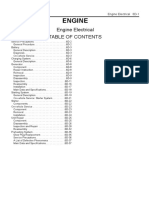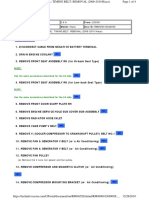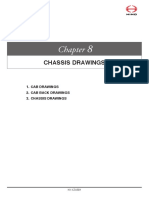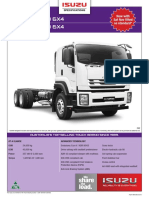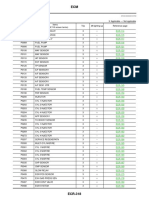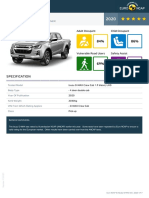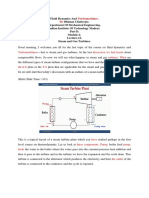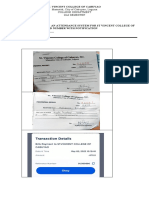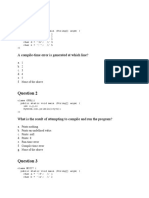Injector Pulse Width
Injector Pulse Width
Uploaded by
msaad19103564Copyright:
Available Formats
Injector Pulse Width
Injector Pulse Width
Uploaded by
msaad19103564Copyright
Available Formats
Share this document
Did you find this document useful?
Is this content inappropriate?
Copyright:
Available Formats
Injector Pulse Width
Injector Pulse Width
Uploaded by
msaad19103564Copyright:
Available Formats
since i just went though this, i thought i should write down what i learned befo re i forgot it.
hopefully it will help some people ... please accept my apologies beforehand for how long and rambling it is ... so her e goes ... the injector timing table is based on crank degrees, and specifies the degree at which the injector pulse should end. so at what we is a way to figure out a pro cess that gives us, for a given rpm and load, what cam degree the injector pulse should end. note that crank degrees go from 0-720 instead of from 0-360 because the crank rotates 2 times for each revolution of the cam. when there is little or no overlap between the closing of the exhaust valve and the opening of the intake valve, it may be desirable to actually start injecting the fuel before the intake valve opens. in this case, the fuel is squirted onto the back of the closed intake valve, because that may help atomize the fuel. but if there is alot of valve overlap, then that approach is not as desirable, b ecause when the intake valve opens, some of the fuel that was waiting to go into the cylinder will get mixed in with the exhaust (and ejected from the cylinder) and therefore not be burned, potentially resulting in a lean condition. so a factor in deciding how early to start the injectors may be how much overlap there is in your cam. here are my thoughts on a process to determine what values to put in the injecto r timing table ... before we can pick an ending degree, we need a way to determine how many degrees the injector needs to provide the right amount of fuel. in order to do that, we need a way to figure out how much fuel is needed. once we know that, we can det ermine how many milliseconds the injector needs to be open to provide the fuel. then need to be able to figure out, for a given rpm, how many degrees the camsha ft will turn during the time the injector is open. then, knowing the degrees at which the valves open and close, we can finally pick reasonable ending degrees f or the injector timing. for a certain rpm and load, we can estimate what the injector pulsewidth would b e. for example, suppose we had a 410 with 42# injectors spinning at 3000 rpm und er 50% load. what would the estimated pulsewidth be? one cylinder has a maximum volume of 410/8, or 51.25 ci. since the volumetric ef ficiency of the engine is not 100%, for our example, let's use .85 as the VE fac tor, which means that a given cylinder will end up with a maximum of 51.25*.85 = 43.5625 ci of air. since our example is at 50% load, that would be 43.5625 *.50 = 21.78125 ci. this is the estimated amount of air (in cubic inches) each cylin der should receive per cycle. there is a conversion factor that says one cubic foot of air contains .075 lbs o f air. so in our example, we have 21.78125 / (12*12*12) = 0.01260489 cubic feet of of air. so we have 0.01260489 * .075 = 0.00094536675 lbs of air now that we know we have 0.00094536675 lbs of air in the cylinder, we can determ ine how much fuel we need ... using the standard air/fuel ratio of 14.67, we wou ld need 0.00094536675/14.64 = .0000645742316 lbs of fuel. since injectors are given in lbs per hour, and pulsewidths are in milliseconds, we need to convert to lbs per ms. so for 42# injectors, we have 42/(60 minutes*6 0 seconds*1000 milliseconds) = 0.0000116666667 lbs of fuel per ms.
so to get .0000644421779 lbs of fuel, we would open the injectors for a pulswidt h of .0000645742316/0.0000116666667 = 5.53493412 ms. but since there is a small delay (about .05 ms) before the injectors actually start squirting the fuel, let s add .05 to the pw, getting about 5.58 for the desired injector pulsewidth. notice that if we figure out the pw for the case where load is 100% (WOT), then we can just multiply that by the load later to simplify things. let's do that he re: max air in lbs: (51.25*.85*.075)/(12*12*12) = 0.00189073351 lbs air fuel needed for max air above: 0.00189073351 / 14.67 = 0.000128884357 lbs fuel fuel in lbs per ms: (42/360000) = 0.0000116666667 ms needed to deliver the above fuel: (0.000128884357 / 0.0000116666667) = 11.05 ms note that we will need to add the .05 ms delay to the pulsewidth after factoring in the load ... so 11.09 ms is needed to deliver the most fuel the injecter should have to deliv er. of course, this will be slightly higher if we want the afr to be lower. like when at WOT for example. we will multiply this to the load later ... ok, we are halfway there... now we get to figure out how many degrees the crank will turn during that 5.58 ms. that depends on how fast the engine is turning. in our example, the engine is turning 3000 rpm. since there are 360 degrees in a revolution, 60 seconds per minute and 1000 ms per second, then we have the cran k turning at (360*3000) / (60*1000) = 18 degrees per ms. so in 5.58 ms, the cran k turns 18 * 5.58 = 100.44 degrees. notice that the only variable above is the rpm, so for a given rpm we can do thi s to get the degrees per ms: 360*(rpm)/(60*1000) = 360*rpm/60000 = rpm*(360/60000) = rpm*0.006 we'll use this later too ... so let's say that our cam has an intake lobe center of 110, a lsa of 112, a dura tion of 230 at .050" and 290 total duration. so how does that translate into cra nk degrees? here's how: by definition, crank degrees 0-360 refer to the first revolution of the crank, a nd degrees 360-720 refer to the second revolution of the crank. intake events are offsets from top dead center (TDC) or bottom dead center (BDC) of the cylinder during the phase in question. for the intake valve events, TDC i s at degree 360. since the intake lobe has a center of 110, that means the valve is open its high est at 360+110=470 degrees. a duration of 290 means that the valve opens at 470(290/2) = 325 and closes at 470+(290/2) = 615 degrees. similarly, the valve is a t .050" or higher from degree (470)+/-(230/2), or 355 and 585 degrees. a lsa of 112 means that the exhaust lobe center is 112*2 degrees before the inta ke lobe center.
so with a lsa of 112, our exhaust valve is fully open (the exhaust lobe center) at 470-(112*2) = 246 degrees. doing the same calcs as above, we have open/close at 101 and 391, and at .050" the open/close events are 131 and 361 degrees. now notice that the exhaust closes at 391, and the intake opens at 325. so both valves are open for 391-325 = 66 degrees. this is the total overlap. similarly, at .050" there is an overlap of 6 degrees. in this case, i would probably want t he fuel to start injecting when the exhaust valve closes, or at about degree 390 . now we are almost there ... for a given load and rpm, we can figure out how much ms of injector we need, and how many degrees that ms needs. now all we have to do is tie that to the cam events for our cam and we can fill in the table with v alues that should be fairly reasonable. to finish off our example, with the 410ci engine and 42# injectors, 50% load at 3000 rpm with our cam as above, the calculation for that cell would be ... the needed injector pw would be: 11.05 * .50 + .05 = 5.595 ms the cam rotation for 5.595 ms at 3000 rpm would be: 3000 *.006 * 5.595 = 101 deg rees (rounded) if the pw starts when the exhaust valve closes ... the injector fires from degree 390 thru 491 (390+101) so 491 should be a fairly reasonable value for that cell.
You might also like
- Covid-19 Hospital Management SystemDocument74 pagesCovid-19 Hospital Management SystemMuhammed Ajmal67% (3)
- Material Safety Data Sheet: Section 1 - Statement of Chemical Product and Company IdentificationDocument7 pagesMaterial Safety Data Sheet: Section 1 - Statement of Chemical Product and Company IdentificationAsadNo ratings yet
- 3FE Desmog GuideDocument13 pages3FE Desmog GuideKevinNo ratings yet
- Removing Mitsubishi Pajero ECUDocument2 pagesRemoving Mitsubishi Pajero ECUJose Gilmer100% (1)
- Shogun 2001 Fuel ProblemDocument6 pagesShogun 2001 Fuel ProblemJose GilmerNo ratings yet
- Sec4 4C PDFDocument77 pagesSec4 4C PDFJipsonCuevaNo ratings yet
- Motor QSB3.3 PDFDocument2 pagesMotor QSB3.3 PDFDiego Paredes100% (1)
- The Factory Boost Jets NAVARA D40Document7 pagesThe Factory Boost Jets NAVARA D40Icram Ibrahimo100% (1)
- Oracle Database 12c Advanced PLSQL - D80343GC10 - 1080544 - USDocument3 pagesOracle Database 12c Advanced PLSQL - D80343GC10 - 1080544 - USJinendraabhiNo ratings yet
- Specification Sheet: Description FeaturesDocument2 pagesSpecification Sheet: Description FeaturesMd ShNo ratings yet
- D4EB-EngineElectricalSystemDocument38 pagesD4EB-EngineElectricalSystemNap Florendo100% (2)
- Differential CaseDocument5 pagesDifferential CaseOmar Jayson Siao VallejeraNo ratings yet
- Adjustments 4 Cyl EfiDocument22 pagesAdjustments 4 Cyl EfifostechNo ratings yet
- 4HK1 Manual 3Document37 pages4HK1 Manual 3Imesh SachinthaNo ratings yet
- 1GD 2GDDocument4 pages1GD 2GDSenaMecánicaElectrónicaNo ratings yet
- Sec 08 Electrical - Body & ChassisDocument202 pagesSec 08 Electrical - Body & ChassisAlie PandhuNo ratings yet
- Kdvu4349 PDFDocument40 pagesKdvu4349 PDFKaryadi Nugroho0% (1)
- Engine: Fuel SystemDocument36 pagesEngine: Fuel Systemdmitry esaulkovNo ratings yet
- Timing Belt RemovalDocument4 pagesTiming Belt RemovalrenimoNo ratings yet
- BT-50 en OrganizedDocument40 pagesBT-50 en OrganizedPao RodNo ratings yet
- Mitsubishi Delica l300 Workshop Repair ManualDocument140 pagesMitsubishi Delica l300 Workshop Repair ManualERDE100% (1)
- Nissan Ud Cwm454 Mhra (Spec Eng) 1Document2 pagesNissan Ud Cwm454 Mhra (Spec Eng) 1Stefanus Tedy0% (1)
- Group 13eb Electronically Controlled Fuel SystemDocument23 pagesGroup 13eb Electronically Controlled Fuel SystemclaudiosilvahNo ratings yet
- 1423105723992Document2 pages1423105723992Marcio MotaNo ratings yet
- Isuzu CYJ460Document2 pagesIsuzu CYJ460Hugo Rodriguez100% (1)
- LG4HG-WE-0871 1st WSMW 085 N G.Exp VN65Document346 pagesLG4HG-WE-0871 1st WSMW 085 N G.Exp VN65ney franko100% (1)
- Level Swichgage For Engine Liquids: L150 and EL150K1 SeriesDocument2 pagesLevel Swichgage For Engine Liquids: L150 and EL150K1 Seriesruyolmos_zeroNo ratings yet
- Isuzu Engine Fuel SystemDocument41 pagesIsuzu Engine Fuel SystemToanNo ratings yet
- 02 Engine Mechanical SystemDocument135 pages02 Engine Mechanical SystemLuisAlbertoMoreno100% (1)
- Hino 300Document18 pagesHino 300Jordy PerezNo ratings yet
- Hino 500 Series Brochure NewDocument6 pagesHino 500 Series Brochure Newtrong phamNo ratings yet
- Fault Code P1830 (Controlled Manual Gearbox ECU)Document2 pagesFault Code P1830 (Controlled Manual Gearbox ECU)thierry.fifieldoutlook.comNo ratings yet
- General: Group 00Document56 pagesGeneral: Group 00Eduardo Enrique Rojas ValenzuelaNo ratings yet
- X-431 Euro Pro HD+: Professional Diagnostic Device For TruckDocument15 pagesX-431 Euro Pro HD+: Professional Diagnostic Device For TruckKadir Koray BozyelNo ratings yet
- Hino Bus Specificationspdf PDFDocument54 pagesHino Bus Specificationspdf PDFGunawan AjahNo ratings yet
- Service and Maintenance Schedule D-MAX 3.0L 4x4 AT X-TerrainDocument1 pageService and Maintenance Schedule D-MAX 3.0L 4x4 AT X-TerrainSyuhaimi ZakariaNo ratings yet
- HINO US Chap04Document51 pagesHINO US Chap04Andres GomezNo ratings yet
- Isuzu FXZ240-350 - FXY240-350Document4 pagesIsuzu FXZ240-350 - FXY240-350Hugo RodriguezNo ratings yet
- DTC PDFDocument3 pagesDTC PDFArif Suharto100% (1)
- Extra2000 User Manual - 2021Document27 pagesExtra2000 User Manual - 2021dush35No ratings yet
- A - C Control System - Autoo PDFDocument4 pagesA - C Control System - Autoo PDFANH LÊNo ratings yet
- 2020 Isuzu D-Max Euro NCAPDocument17 pages2020 Isuzu D-Max Euro NCAPcarbasemyNo ratings yet
- Hit Fuel System PDFDocument22 pagesHit Fuel System PDFLinzaw OoNo ratings yet
- GPR Auto Transmission PackageDocument18 pagesGPR Auto Transmission PackageRajibNo ratings yet
- Details of MightyDocument40 pagesDetails of MightyHung Nguyen Dinh100% (1)
- DTC C2311 HV Communication Line Malfunction: Circuit DescriptionDocument3 pagesDTC C2311 HV Communication Line Malfunction: Circuit Descriptionoliver lealNo ratings yet
- Generator Model: P 200: Prime Power 200 KVA 160 KWDocument4 pagesGenerator Model: P 200: Prime Power 200 KVA 160 KWMuhammad AtifNo ratings yet
- Mitsubishi DelicaDocument104 pagesMitsubishi DelicaGabriel BalcazarNo ratings yet
- Honda DTC Codes PDFDocument12 pagesHonda DTC Codes PDFZayn SilangNo ratings yet
- No. Maker Exd No. Reference No. Vehicle Eng/Model (An Example) P/YDocument18 pagesNo. Maker Exd No. Reference No. Vehicle Eng/Model (An Example) P/YDevin ZhangNo ratings yet
- Marine Diesel Engines (D6AC) : ProductDocument3 pagesMarine Diesel Engines (D6AC) : Producthexxa3000No ratings yet
- Gigamax Exy 510 6X4 Australia PDFDocument4 pagesGigamax Exy 510 6X4 Australia PDFdionymackNo ratings yet
- Manual de Mecánica Toyota 3ADocument7 pagesManual de Mecánica Toyota 3AElmer Aldair Inoñan VilchezNo ratings yet
- Transmission Control LinkageDocument16 pagesTransmission Control Linkagedmitry esaulkovNo ratings yet
- (Oto-Hui - Com) Edc Hino s05Document2 pages(Oto-Hui - Com) Edc Hino s05ahmed_eng_1500No ratings yet
- HFC Hydrogen Fuel Cell Cars: The Next Generation in Electric CarsFrom EverandHFC Hydrogen Fuel Cell Cars: The Next Generation in Electric CarsNo ratings yet
- Angle - Area & Time - AreaDocument3 pagesAngle - Area & Time - AreaNick FernandoNo ratings yet
- Cálculo de InjetoresDocument3 pagesCálculo de InjetoreslucianofcaNo ratings yet
- How ToDocument45 pagesHow ToDHAVALESH AMNo ratings yet
- CFM Demand & The Minimum Cross-Sectional AreaDocument3 pagesCFM Demand & The Minimum Cross-Sectional AreaGoranPopovićNo ratings yet
- Turbomachines Discussion We Had Learnt Turbines. WhatDocument14 pagesTurbomachines Discussion We Had Learnt Turbines. Whatgavin_d265No ratings yet
- Shut Off Calculation For Centrifugal PumpDocument3 pagesShut Off Calculation For Centrifugal PumpsubratorajNo ratings yet
- 11 - 8 Steps To Success in Maintenance Planning and Scheduling PDFDocument42 pages11 - 8 Steps To Success in Maintenance Planning and Scheduling PDFmsaad19103564100% (2)
- 00 - Earthwork NotesDocument47 pages00 - Earthwork Notesmsaad19103564No ratings yet
- As Tronic Operators ManualDocument42 pagesAs Tronic Operators Manualmsaad19103564100% (1)
- Team Teaching Presentation How Car Suspension WorksDocument17 pagesTeam Teaching Presentation How Car Suspension Worksmsaad19103564No ratings yet
- Sales Order AcknowledgementDocument1 pageSales Order Acknowledgementmsaad19103564No ratings yet
- Power Take-Off (PTO) Description and OperationDocument5 pagesPower Take-Off (PTO) Description and Operationmsaad19103564No ratings yet
- Common RailDocument11 pagesCommon Railnitishghosal100% (1)
- React Developer: Nanodegree Program SyllabusDocument12 pagesReact Developer: Nanodegree Program Syllabusɪꜱᴍɪʟᴇʏ.No ratings yet
- Unit 1Document29 pagesUnit 1SwaasNo ratings yet
- Cap202 - Object Oriented Programming SyllabusDocument2 pagesCap202 - Object Oriented Programming SyllabusbalachanduNo ratings yet
- ME-B Engine Control SystemDocument11 pagesME-B Engine Control SystemMelih Pekara100% (1)
- Paket 5000 Up 734 07.01.22 01 07 2022Document7 pagesPaket 5000 Up 734 07.01.22 01 07 2022pathul azizNo ratings yet
- RENK France Powerpack 350S EN Ed.03 16 PDFDocument5 pagesRENK France Powerpack 350S EN Ed.03 16 PDFkkrgopiNo ratings yet
- Security and Control MISDocument20 pagesSecurity and Control MISJaipuneet Arora0% (1)
- Chapter 1 Introduction To Enterprise Systems For ManagementDocument10 pagesChapter 1 Introduction To Enterprise Systems For ManagementSughand JeswaniNo ratings yet
- Chapter 1Document6 pagesChapter 1Gulelat YNo ratings yet
- Maintenance PlanningDocument9 pagesMaintenance PlanningPablo PorcelanaNo ratings yet
- OS I UnitDocument9 pagesOS I UnitMukul PalNo ratings yet
- Online Exam System in PHP Project ReportDocument29 pagesOnline Exam System in PHP Project ReportPinky PaliwalNo ratings yet
- UMS TestcasesDocument6 pagesUMS TestcasesBhumika BiyaniNo ratings yet
- S.E Defense Receipt and ActivityDocument9 pagesS.E Defense Receipt and ActivityMhie RecioNo ratings yet
- TDD With PHP - The Secret of Coding With ConfidenceDocument27 pagesTDD With PHP - The Secret of Coding With ConfidenceSingapore PHP User Group100% (1)
- 84P53TmPQGmD d05jxBp A Activity Exemplar Use A WBS To Create Project Tasks and Milestones Part 2Document1 page84P53TmPQGmD d05jxBp A Activity Exemplar Use A WBS To Create Project Tasks and Milestones Part 2Maurice PatelNo ratings yet
- Function Point AnalysisDocument8 pagesFunction Point AnalysisRakshikaMNo ratings yet
- Resume: P Sudhakar Mobile:91-8978594897Document3 pagesResume: P Sudhakar Mobile:91-8978594897Koteswararao TNo ratings yet
- Test IDocument3 pagesTest IValdez, Kaycee M.No ratings yet
- Uniware eDocument8 pagesUniware eGaneshNo ratings yet
- Software Quality Assurance - OutlineDocument37 pagesSoftware Quality Assurance - OutlineJeetendra KumarNo ratings yet
- Lean and Jit Systems: Originated From: Operations Management, 8 Edition, William J Stevenson Mcgraw-HillDocument33 pagesLean and Jit Systems: Originated From: Operations Management, 8 Edition, William J Stevenson Mcgraw-HillMuhammad HarizNo ratings yet
- IS Audit Checklist in ExcelDocument11 pagesIS Audit Checklist in ExcelAnand.Sonie100% (3)
- Functional and Non-Functional Testing: CO4: The Use of Various Test ToolsDocument5 pagesFunctional and Non-Functional Testing: CO4: The Use of Various Test Toolsraghav dhamaniNo ratings yet
- PurposeDocument2 pagesPurposeSmitha DanielNo ratings yet
- CV AbhitahDocument1 pageCV AbhitahAbhitah JanitraNo ratings yet
- Java MCQs 2Document11 pagesJava MCQs 2sandeepaprNo ratings yet













